Red Palm Weevil: Rhynchophorus ferrugineus
Symptoms of Damage:
- The hole can be seen on the stem with chewed up fibres protruding out.
- Many times reddish brown liquid can be seen oozing out from the hole.
- The grubs cause damage inside the stem or crown by feeding on soft tissues and often cause severe damage especially when a large number of them bore into the soft, growing parts. In case of severe infestation the inside portion of trunk is completely eaten and become full of rotting fibres.
- In case of young palms the top withers while in older palms the top portion of trunk bends and ultimately breaks at the bend (wilting).
- Sometimes the gnawing sound produced by the feeding grubs inside will also be audible.
- In the advanced stage of infestation yellowing of the inner whorl of leaves occur. The crowns falls down or dry up later when palm is dead.
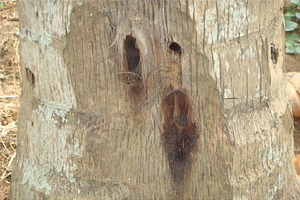 |
 |
Holes on the stem
|
chewed up fibres |
Identification of the Pest:
- Egg: Oval and creamy white in colour. Eggs laid in scooped out small cavities, wounds and other cut injuries on the trunk
- Grub: Light yellowish grub without legs. Stout, fleshy and apodous with a conical body bulged in middle and tapering towards the end
- Pupa: The full frown larva pupates inside the stem and fibrous cocoon made out of fibrous strands
- Adult: Reddish brown weevil has six dark spots on thorax. Male has conspicuous long snout has a tuft of hairs.
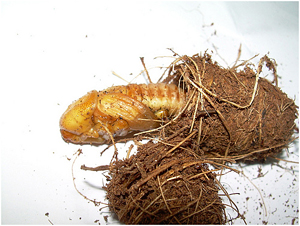 |
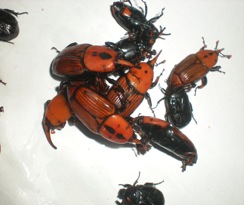 |
Pupae
|
Adult |
Management:
Cultural Method:
- Remove and burn all wilting or damaged palms in coconut gardens to prevent further perpetuation of the pest.
- Avoid the cutting of green leaves. If needed, they should be cut about 120 cm away from the stem in order to prevent successful inward movement of the grubs through the cut end.
Chemical Method:
- In attacked palms, observe for the bore- holes and seal them except the top most one. Through the top most hole, pour 1% carbaryl (20gm/lt) or 0.2% trichlorphon @ one litre per palm using a funnel. Then plug this hole also. If needed repeat after one week.
- When the pest infestation is through the crown, clean the crown and slowly pour the insecticidal suspension. In case of entry of weevil through the trunk, the hole in trunk may be plugged with cement / tar. A slanting hole is made with the aid of an auger and the insecticide solution is poured with funnel.
- Fill the crown and the axils of top most three leaves with a mixture of fine sand and neem seed powder or neem seed kernel powder (2:1) once in three months to prevent the attack of rhinoceros beetle damage in which the red palm weevil lays eggs.
Trap Method:
Coconut log traps:
- Setting up of attractant traps (mud pots) containing sugarcane molasses 2½ kg or toddy 2½ litres (or pineapple or sugarcane activated with yeast or molasses) + acetic acid 5 ml + yeast 5 g + longitudinally split tender coconut stem/logs of green petiole of leaves of 30 numbers in one acre to trap adult red palm weevils in large numbers. Incorporate any of the insecticide to each trap to kill the weevils trapped.
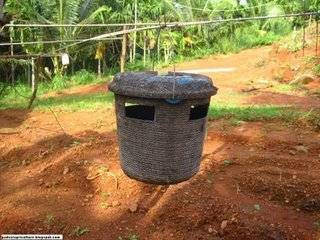 |
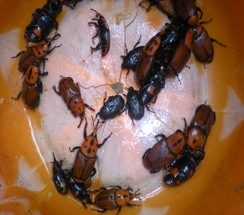 |
Pheromone lure with bucket
|
Trapped Red Palm Weevil |
Pheremone trap
- Install pheromone trap @ one trap per ha
- Step 1: Specialized buckets with 3 of 4 holes are made, the bucket is wound with coconut fibre/ jute sack, so that the pests can enter.
- Step 2: The lure (Ferrolure +) is suspended inside the bucket and one lit of water is added along with 100g pineapple/ sugarcane, 2g yeast and 2g Carbaryl in the bucket.
- Step 3: The bait buckets are placed at sites in the farm, where infestation is seen most.
- Step 4: After a week the water is checked for the catch & re filled to prevent mosquitoes from breeding.
|






